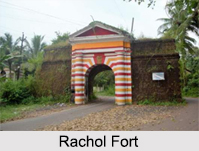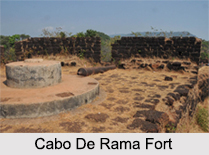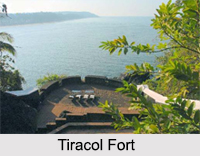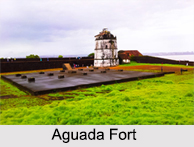 The forts in Goa were mostly built by the Portuguese rulers to secure their territories from invasions from mighty rulers like the Marathas. There are a number of forts in Goa which have been the prime attractions of the state. They form an important part of the historical monuments of Goa and attract tourists from different places throughout the year.
The forts in Goa were mostly built by the Portuguese rulers to secure their territories from invasions from mighty rulers like the Marathas. There are a number of forts in Goa which have been the prime attractions of the state. They form an important part of the historical monuments of Goa and attract tourists from different places throughout the year.
Fort Naroa
Fort Naroa, located on the Island of Divar in Goa was built by the Muslims and was abandoned in 1834. Currently, the fort now stands in complete ruins but an old garrison church is adjacent to the fortress that still serves the locals. Though the church is dedicated to the Holy Spirit, a statue of St Thomas adorns the main altar. This fort was a pilgrimage site and also housed a Hindu temple that remained up to the time of Portuguese conquest.
Rachol Fort
Rachol Fort in Goa is famous for its rich historical significance involving the battles of Vijayanagar and Bijapur. This magnificent fort is situated adjacent to the Rachol Seminary, about 7 km away from the town of Margao. Of the fortress itself, only a single gateway remains in existence, straddling the road which leads to the seminary.
Chapora Fort
Chapora Fort in Goa was built by the Portuguese in the year 1617 and was constructed to secure the occupied territory in Goa by the Portuguese. But in the later years, the Portuguese abandoned the fort in 1892. Presently nothing but the ruins of the fort remains.
 Cabo de Rama Fort
Cabo de Rama Fort
Cabo de Rama Fort of Goa derives its name from the Hindu God, Lord Rama. Believed to be a fort of the Hindus, the fort is said to have taken over by both the Portuguese and British people.
Fortress of Colvale
Fortress of Colvale was built in the year 1681 in order to prevent the invasion of the Marathas and Bhonsles. Presently the Fortress of Colvale is in ruins. The fort was neglected and abandoned for years.
Reis Magos Fort
Reis Magos Fort was built in order to protect the entry point of Goa, at the mouth of River Mandovi. It was constructed by the Portuguese in the year 1551. In the present day, the fort is in a quite good state of maintenance and in its base lies the Reis Magos Church.
 Tiracol Fort/ Terekhol Fort
Tiracol Fort was built on the Terekhol River banks and is also known as the Terekhol Fort. It was constructed by Maharaja of Sawanwadi. However, it was reconstructed in 1764 after it was overtaken by the Portuguese. Presently this Terekhol Fort has been transformed into a heritage hotel.
Tiracol Fort/ Terekhol Fort
Tiracol Fort was built on the Terekhol River banks and is also known as the Terekhol Fort. It was constructed by Maharaja of Sawanwadi. However, it was reconstructed in 1764 after it was overtaken by the Portuguese. Presently this Terekhol Fort has been transformed into a heritage hotel.
Aguada Fort
Aguada Fort was built in the year 1612. The fort derives its name from the Portuguese word, `Aguada`, meaning water. The fort was built to secure the state from outside invasions. A hotspot of various natural springs was a part of this famous fort that has been changed into central jail.
Sinquerim Fort
The Sinquerim Fort was built in the year 1612 and stands overlooking the Sinquerim Beach, it bisects the shoreline into two. Basically, this fort is the lower extension of the Aguada Fort. The fort was constructed to guard Goa against the Dutch and the Marathas and also served as a reference point for vessels coming from Europe.
Mormugao Fort
Mormugao Fort is located near the Marmagoa Harbor. The construction of the fort began in the year 1624. The fort housed 53 guns, a garrison and 4 officers. This was earlier an important monument of the western coast that now lies mostly in ruins except for its boundary walls and chapel.
Corjuem Fort
A fortress on the river island of Corjuem, Goa, the Corjuem Fort used to be the military fortress for the defence of Portuguese India. Built in 1705, the fort is separated by the Mapuca River, which is a tributary of the Mandovi. It is one of the two inland forts that survive today and is also known as the Khorjuem Fort. The Corjuem Fort is smaller than the other forts in Goa, but it gives a good view of the surrounding river and land.
 Anjediva Fort
Anjediva Fort
Located on the border of Goa and Karnataka, the Anjediva Fort was built by the Portuguese in the year 1505 AD. The fort sprawls over an area of 1.5 sq km on the Anjadip Island. The history of the Anjediva Fort is rich but is now currently in ruins. There is a historic church on the vicinity of the fort, the Church of Our Lady of Springs built in 1505 and the Chapel of St. Francis D" Assissi is located here but is in ruins. The Department of Archaeology and Museums of Goa has conducted certain excavations at the site of the Anjediva Fort. Pots belonging to the 11th and 12th centuries, ancient pillars, stones and the creative works of the Chalukyas and Kadambas have been discovered from this region. Archaeologists have determined from that artefacts revealed that they might be the ruins of an ancient, destroyed temple dedicated to a Goddess named Aryadurga Devi.
Nanuz Fort
Located in the Sattari taluka of North Goa, the Nanuz Fort was built in the 17th century by the Maratha ruler, Shivaji. The Nanuz Fort has been known to be the prime centre during the times of revolts in Goa. The fort today is mostly in ruins and although it is small in size, draws many tourists.




